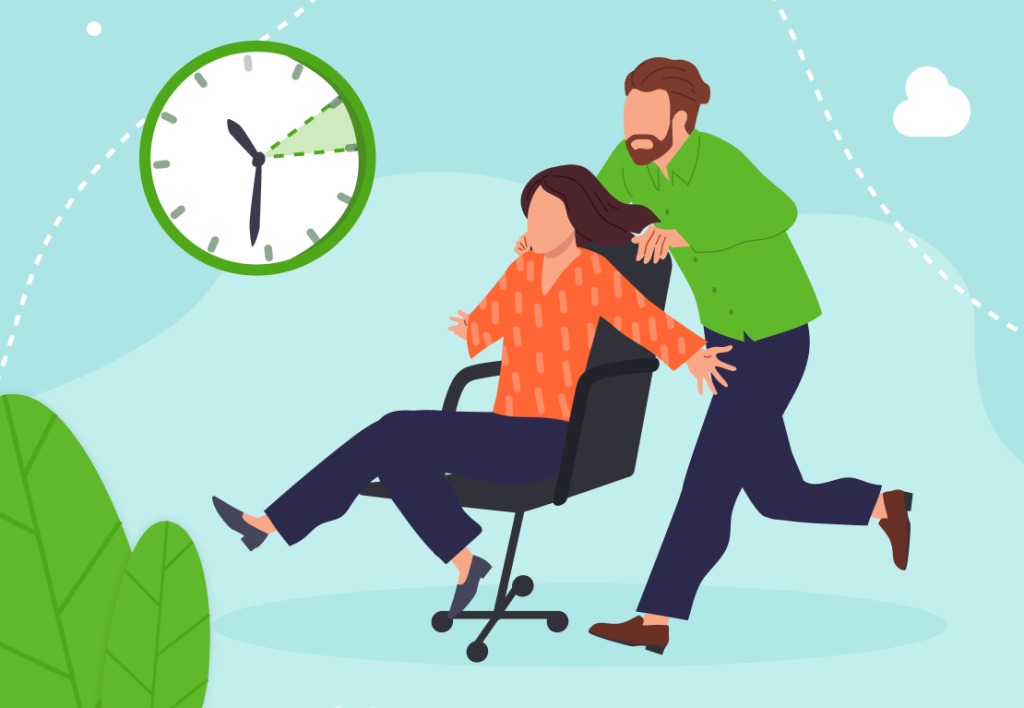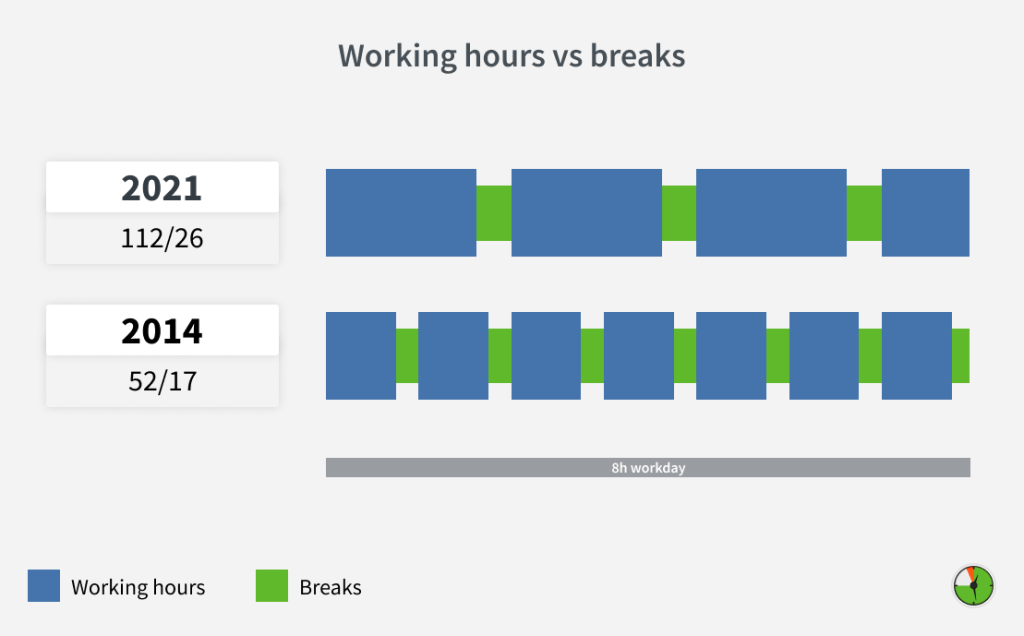Does the 52-17 rule really hold up?

You may have heard of the 52-17 method to achieve maximum productivity at work. The ratio has been cited by scientific research papers, there are dozens of 52/17 productivity apps, and to this day people recommend it as one of the best productivity hacks.
But did you know it was us at DeskTime who discovered and coined this principle? Back in 2014, we ran a study that found out this was the preferred work-to-break ratio for the most efficient workers.
Want to get the most out of your time?
Try DeskTime for free!
Try free for 14 days · No credit card required.
By signing up, you agree to our terms and privacy policy.

So, what is the 52-17 rule? Does it still hold true? What has changed and are there any new data-backed insights for the most productive use of your work hours?
As the original study celebrates its 10-year anniversary, we look back at our original findings and break down the 52-17 ratio and its evolution over the years—including a recent repeat study that (spoiler alert!) returned a brand new ratio.
The 52-17 rule explained
In 2014, we performed a study analyzing the top 10% of the most productive people to see what they had in common with the way they work.
DeskTime is a productivity tracking software that collects vast amounts of data on daily computer usage. One of the aspects of a workday the software can track is an employee’s productivity, calculating the percentage of time spent on apps and websites considered productive for that particular employee (e.g., a marketer would indicate social platforms like Facebook as “productive.”).
We isolated the top 10% of most productive employees—those with the highest ratio of using productive applications for their work. Then, we analyzed their computer-use behavior during one workday.
The data revealed that the most productive people work for 52 minutes, then break for 17 minutes. Hence, the 52/17 ratio.

This means that taking quality breaks must be an essential part of your workday to achieve maximum productivity. The employees with the highest productivity ratings, for the most part, don’t even work 8-hour days. Their secret to retaining the highest level of productivity is not working longer but working smarter with frequent breaks—52-17.
We originally shared our findings with the Daily Muse, but the article on the 52-17 method took off and was republished by Mashable, Business Insider, Inc.com, and Lifehacker, becoming a global phenomenon.
But is the 52-17 work-to-break ratio still the most efficient one? A few years ago, we ran the study again to see what had changed over time.
Did the pandemic change our habits? Going from 52-17 to 112-26
In 2021, we repeated the experiment, using the same principle to see if the habits of the most productive people had changed over the previous years.
And they had. Now, the best work-break ratio for maximum productivity was revealed to be 112-26. This means the most productive people, on average, work for 112 minutes and then take a 26-minute break—working longer but taking more time to decompress.

Back in 2021, we were still experiencing the peak pandemic era, so it might seem logical to conclude that this change was caused by many employees switching to remote work. People would be interrupted less than in the office and could take longer to decompress by taking care of some errands at home.
To test this idea, we extracted the data from February 2020, right before the pandemic impacted the working lives of people worldwide. Right before the pandemic, the productivity ratio was 80-17—80 minutes of working sprints, followed by an average of 17-minute breaks. So, while the number of work minutes before taking a break had been on a slow uprise before the pandemic, the switch to remote work supercharged it, changing people’s habits drastically.
This correlates with other studies done on working hours during the pandemic, which found that people tended to work longer and harder in a remote environment. In this situation, the importance of quality breaks becomes even more pronounced. You don’t want employees to burn out, and tracking work hours with a tool like DeskTime can help maintain a healthy work-life balance.
52-17 vs. the Pomodoro technique
Any discussion about the best work-to-break ratios would be incomplete without mentioning the Pomodoro technique.
Similar to 52-17, this is another approach aimed at achieving the best productivity by mixing bursts of focused work with quality breaks. The Pomodoro technique has been around since the 1980s, and it proposes a shorter work spurt mixed with shorter breaks—a 25-5 or 25-10 ratio. In addition, after you’ve completed four Pomodoro rounds, you should take a longer break (20–30 minutes).
Fun fact: The technique gets its name from the tomato-shaped timer its Italian inventor used to track the time.
The Pomodoro method has been tried and tested by many workers over the years, and the fact that we’re still talking about it proves that it can deliver results too. However, a deep dive into DeskTime’s data showed that longer work spurts mixed with longer breaks seem to boost employee productivity even more.
Which is the most efficient work-to-break ratio?
With so many options and findings available, you might wonder—which is the best work-break ratio after all?
The fact is that there is no one-size-fits-all approach. We all have our own approach to work hours and how to get the most out of them. So, the way to determine the work-to-break ratio that works for you is to test all of the methods we’ve outlined and measure what brings the best results.

Use a productivity tracking app like DeskTime to track your effectiveness and productivity with each method and find out which one suits your style of work more. You can also experiment with different approaches for different types of tasks. Perhaps one method works better when you’re engaged in a task that requires more deep work, like planning or writing, whereas something less demanding can benefit from a different work-to-break ratio.

Invite structure in your workday!
Track time automatically with DeskTime and take back control over your hours
The common denominator—breaks! Here’s how to make the most of them
Although all of these methods stress the importance of break time, not all breaks are the same. Whether you follow the 52-17, 112-26, or the Pomodoro method, the quality of your breaks will affect the quality of your work.
Bring some variety to your day:
- Exercise—there are plenty of small workouts you can do in the confines of an office. Fitness wristwatches or apps can remind you when you’ve been at the computer for a while and urge you to exercise.
- Take a walk—better yet, go outside. Not only will it clear your mind, but you’ll also get oxygen to make your brain work better, plus you might catch some rays. Vitamin D makes for a better mood, further stimulating your ability to concentrate.
- Grab something to eat—replenish those energy levels. The best foods to boost concentration and productivity are nuts, avocados, blueberries, fish meat, and – yay – dark chocolate.
- Talk to your colleagues—research shows that employees who socialize are happier at work and can do as much as their non-socializing co-workers.
- Surf social networks—because this is your time to do what you want. Make sure to take a moment to look away from the computer or smartphone and gaze into the distance to relieve your near-focused eyes.
- Watch funny cat videos—it’s proven that by looking at cute pictures of cats and dogs you can actually become more productive.

Power up your productivity
The real secret to productivity lies in flexibility. If the traditional 52-17 rule or the Pomodoro technique works for you, great! But if you see you benefit from longer work sessions or more frequent breaks, don’t be afraid to adapt.
Your goal is to keep up your energy, creativity, and motivation throughout the day. So feel free to experiment and find the rhythm that helps you achieve new productivity levels. The best way to do it? Try different techniques and track your productivity with DeskTime to see what works and what doesn’t.
Did you find this article useful? Give it a clap!
Psst! You can clap more than once if you really loved it 🙂